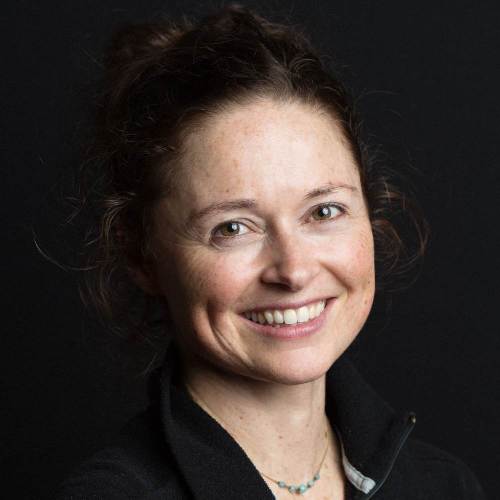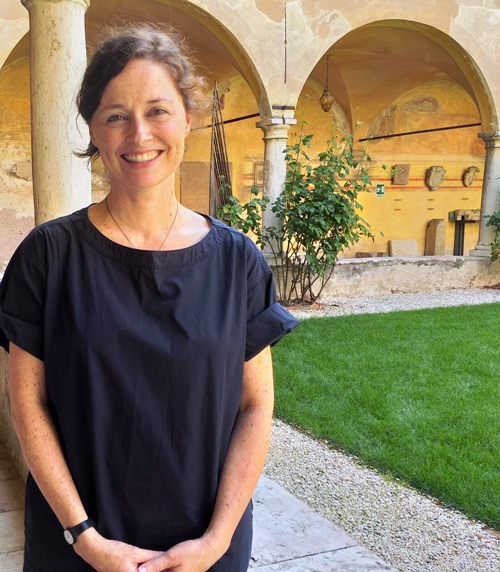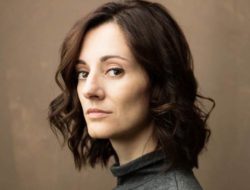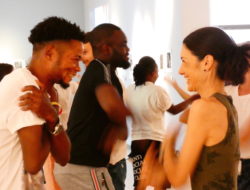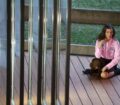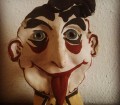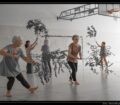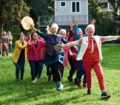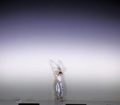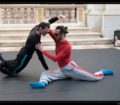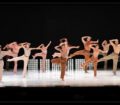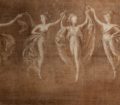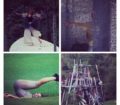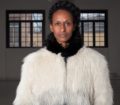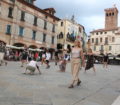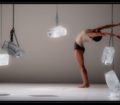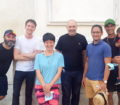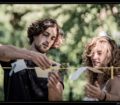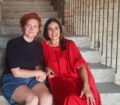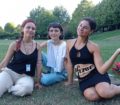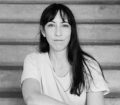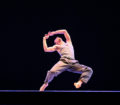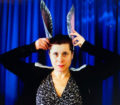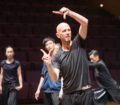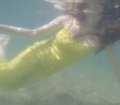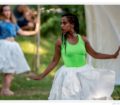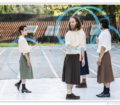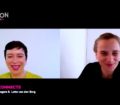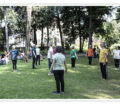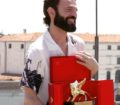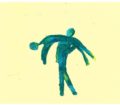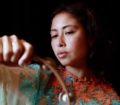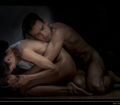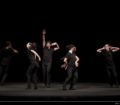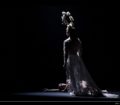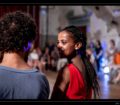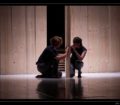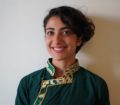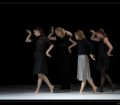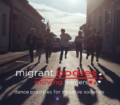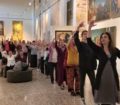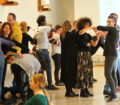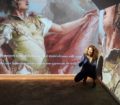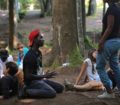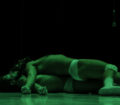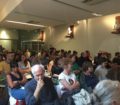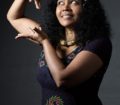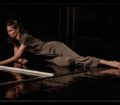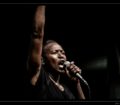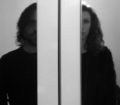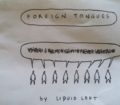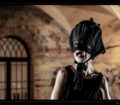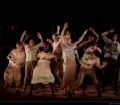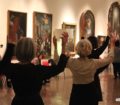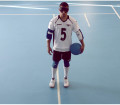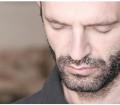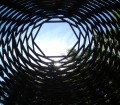ENG | 13 July 2019, Symposium Migrant Bodies-Moving Borders, Bassano del Grappa | I met Monica Gillette at Bassano’s Civic Museum, in the fading light of the hall where the intense debate had just taken place between the artists and dancers Sangeeta Isvaran and Bita Bell, moderated by Monica herself. She is an artist, an American dancer-choreographer, now living and working in Germany. She edited the publication Migrant Bodies – Moving Borders. Dance practices for inclusive societies, a polyphonic glossary that draws on the emotional, intellectual and artistic strands of the biennial experience: the conclusions from that homonymous project. Here is an excerpt from the interview.
ITA | 13 luglio 2019, Simposio Migrant Bodies | Incontro Monica Gillette al Museo Civico, nella penombra della sala dove si è appena concluso l’intenso dibattito da lei moderato tra le artiste e danzatrici Sangeeta Isvaran e Bita Bell. Monica è un’artista, danzatrice coreografa statunitense, che oggi vive e lavora in Germania. Ha curato la pubblicazione Migrant Bodies – Moving Borders. Dance practices for inclusive societies, un glossario polifonico che tira le fila emotive, intellettuali ed artistiche dell’esperienza biennale frutto dell’omonimo progetto. Qui un estratto dell’intervista. La versione italiana è disponbile dopo il testo inglese.
What is a migrant body for you?
I am a migrant body. I am a migrant. I don’t live in the country in which I was born.
When we say words like “migrant”, “refugee”, “asylum seeker” we use them as a label which refers to the largest part of the World. Most people are migrants but in our context, an artistic one, “migrant” is a type of label that we are also trying to break, in a way. It is not seen as something negative, but universal.
[…]
What have you discovered about yourself, about dance, about migration, about migrants during this project?
A lot. Now having watched the documentary Migrant Bodies by Max Biskup today […] I realised how much these last two years had made me far more sensitive and, at the same time, stronger. To be able to stand and be inside very challenging, hard situations. There is always a push-pull, a tension.
I think that there are always moments where it feels very uncomfortable, very painful, very sad in certain encounters, in certain circumstances. Then, because of the dance practices and what we are doing with dance and how we are having these encounters, very quickly it can flip to joy and the sheer pleasure of connectivity. There is a constant push-pull or shifts between extreme emotions that ultimately, I’d go as far to say, a healing place, because of the collectivity and the ‘group-ness’. Even if I just dance with someone for only for one task, two or three minutes, if I’m really fully present and connecting with that person, that has shaped me, that has altered me as a human, because I’m so involved in Migrant Bodies, I accumulated all of those. I am shaped differently now, I am a different person now, because of this journey. I have even more confidence in dance. I have even more faith, more trust, more belief in the power of what dance can do. […]
I have became much more aware of this entire context and how it can be instrumental inside of societal situations, societal contexts… Clearly, very directly, a way to facilitate a more inclusive society. I think that we have the tools at our disposal for this, inherently within our practice and our field and our knowledge that we have as dance artists. […]
Could you tell us an anecdote, an episode or an encounter which was funny, sad or relevant, which occurred during the project?
[…] One of the strongest encounters for me was at the very beginning of the project, a year and a half ago, when we had the first workshop week, here in Bassano. Katharina Senk gave us the task of being opposite another person and each had to try to hit or touch the head of that other person. I found myself in front of a very tall black man and… I grew up a violent city: Los Angeles. So, I was mugged, robbed at gun-point, I really had violent situations in the city of Los Angles. So, normally, if there’s a big guy in front of me whom I don’t know […] my body will automatically retreated and recoil and hold in a bit. So here I am sitting with a man in front of me who was equally as uncomfortable as I was, not able to look me in the eye. And now we had to start, in theory, attacking each other but in a funny way. We both were highly uncomfortable. He had been asked to hit the head of a white woman, and I had been tasked to hit the head of a black man. We were very aware of our social setting, we had not been really giving permission but the whole thing was — “what is this?!”
But then, within 30 seconds, we were laughing, we were enjoying it, once we had passed the initial awkwardness, I realised, in a small way, that this simple task healed me of my own baggage, my own load that I had brought from my history and from my locale, my situation. And I thought: ‘Wow! I could have this experience with a stranger and feel healed from my own trauma’. It meant so much for me in this setting. I have no idea what it had meant for him but in the end we were looking into each other eyes and we couldn’t do it at the very beginning and so that alone was a victory [laugh].
What’s you favourite key-word of the Migrant bodies glossary?
“Help” is one word I felt important to put forward. […] I wrote the entry for “help”. It’s an important word for me, because I wanted to break the usual understanding of how much of the Western and European world is always oriented towards help. […] What I’ve felt that’s really important is to break the hierarchy. “Help” is something of a two-way street, that it goes back-and-forth. It’s an exchange, a dialogue. If you only are thinking of helping in one direction, very often you can be taking the dignity away from the person you are trying to help or… reducing them to levels where they don’t have the chance to give back or exchange with you. I think something that became really affirming or reinforced for me in this project is how to constantly be looking for equality, that whatever scenario we might bring in as a dance artists or people in this project, as the facilitators of the project, whatever action we might bring, that we always look for, where’s the space where we can receive. Help: it’s best to think of it as a constant ebb-and-flow, give-and-take, back-and-forth.
“Transformation” is an another really big word for me, because all dance is transformation. Transformation of state, transformation of beliefs, transformations of locality, transformation of the body and of the mind. Dance is the vehicle, such a beautiful vehicle, to feel transformation, to experience transformation and to embody transformation. When you are doing it in a group, and with a group of strangers, it is an event that brings heightened levels, it almost makes it faster, even if sometimes we ought to go much slower [laugh].
Anna Trevisan
ITA | Che cos’è per te un “migrant body”, un corpo migrante?
Io sono un corpo migrante, sono una migrante, perché non vivo nel paese dove sono nata. Quando pronunciamo parole come “migrante, “rifugiato”, “richiedente asilo”, usiamo categorie che riguardano la maggior parte del mondo. La maggior parte delle persone infatti sono migranti ma in questo contesto, un contesto artistico, parole come “migrante” sono categorie che vogliamo rompere, in un certo senso. Perché il termine “migrante”, in questo contesto, non ha un valore negativo, è una categoria universale.
Che cosa hai scoperto di te, della danza, delle migrazioni e dei migranti durante questo progetto?
Moltissimo. Oggi, guardando il film documentario Migrant Bodies di Max Biskup ho capito quanto questi ultimi due anni mi abbiano reso più sensibile e, al tempo stesso più forte e capace di affrontare situazioni difficili e piene di sfide.
È stato come un “tira e molla”, una tensione continua. Ci sono stati momenti di forte disagio, incontri o circostanze molto dolorosi, molto tristi. Ma poi, grazie alla danza e alla pratica della danza che ha filtrato questi incontri, in un lampo tutto è diventato gioia e puro e semplice piacere di essere connessi uno all’altro. C’e stato sempre questo “tira e molla”, un’oscillazione continua tra emozioni forti e molto distanti tra loro. Ma alla fine, mi sento di dire che tutto questo è stato terapeutico, grazie al lavoro insieme, grazie al gruppo. Anche se ho danzato con qualcuno soltanto per qualche momento, per la durata di un esercizio, questo mi ha cambiata, ha modificato la mia umanità, perché mi sento così coinvolta in Migrant Bodies, e di tutto questo ho fatto tesoro.
Oggi mi sento diversa, la mia persona è stata rimodellata da queste esperienze, da questo viaggio. E ho ancora più fiducia nella danza. Ho ancora più fede e stima, credo ancora di più nel potere di quello che la danza può fare. […] Sono diventata molto più consapevole di come la danza possa essere strumento sociale, di come possa facilitare in modo molto chiaro e diretto l’inclusione sociale. Credo che nel nostro campo noi danzatori, noi artisti abbiamo a disposizione in modo intrinseco questi strumenti, sia attraverso le pratiche di danza che attraverso le conoscenze teoriche.
Puoi raccontarci un aneddoto, un episodio o un incontro divertente, triste o rilevante che ti è capitato durante il progetto?
[…] Uno degli incontri più forti per me è stato proprio all’inizio del progetto, un anno e mezzo fa, durante la prima settimana di seminario, qui a Bassano. Khatarina Senk ci aveva proposto un esercizio di improvvisazione. L’esercizio consisteva nello stare di fronte ad un’altra persona e provare a colpire o a toccarle la testa. Mi sono trovata di fronte un omone nero e … Sai, sono cresciuta in una città violenta: Los Angeles. Ho subito aggressioni, mi hanno derubata puntandomi contro una pistola, ho vissuto situazioni davvero violente a Los Angeles. Quindi, normalmente, se davanti a me c’è qualcuno che non conosco […] il mio corpo automaticamente si ritrae, indietreggia e si irrigidisce all’istante.
E in questo esercizio me ne stavo seduta davanti ad uno sconosciuto che era a disagio almeno quanto me e che non riusciva a guardarmi negli occhi. Dovevamo iniziare, in teoria, ad aggredirci, anche se per gioco. Eravamo tutti e due davvero molto a disagio. A lui era stato chiesto di colpire in testa una donna bianca, e a me era stato chiesto di colpire in testa un uomo nero. Eravamo ovviamente consapevoli del contesto in cui eravamo, non ci eravamo esplicitamente chiesto il permesso ma insomma la situazione per noi due suonava come un: “Che diavolo è questo?”. Eppure, nel giro di trenta secondi siamo scoppiati a ridere e abbiamo cominciato a divertirci, una volta superato l’imbarazzo iniziale. Questo semplice esercizio mi ha guarito dal mio fardello, dalla mia storia. E ho pensato:”Incredibile! Grazie ad uno sconosciuto sono guarita dai miei traumi”. Ha significato così tanto per me tutto questo. Non so che cosa abbia significato per lui, so solo che alla fine ci guardavamo negli occhi e che all’inizio non ci riuscivamo. Fosse anche questo soltanto, è una vittoria! (risata)
Qual’è la parola che preferisci del Migrant Bodies Glossary?
“Help”, “aiuto” è una delle parole che considero più importanti. Ho scritto io questa voce del glossario. La considero importante, perché vorrei contribuire ad abbattere il modo in cui di solito gli Occidentali e gli Europei tendono ad interpretarne il significato.
È importante per me rompere la gerarchia. “Aiuto” è una strada a doppio senso, dove si va avanti e indietro. È uno scambio, un dialogo. Se pensi di poter aiutare in una direzione sola, spesso porti via la dignità alla persona che stai cercando di aiutare, le togli la possibilità di restituire o di scambiare qualcosa con te.
Credo che quello che è diventato davvero imperativo per me in questo progetto è l’attenzione costante alla parità. Qualsiasi scenario fosse quello in cui eravamo coinvolti come artisti, come persone, come facilitatori, qualsiasi azione avessimo intrapreso, per me era fondamentale che fossimo sempre attenti a questo, ad uno spazio dove potessimo anche ricevere. “Help”, “Aiuto”, va pensato come un flusso costante di dare e ricevere, come una marea che si muove avanti e indietro.
“Transformation”, “trasformazione” è un’altra parola veramente grande per me, perché la danza è trasformazione. Trasformazione di stato, di fede, di luogo, trasformazione del corpo e della mente. La danza è il mezzo, un tale, meraviglioso mezzo, per sentire la trasformazione, per esperirla e per incarnarla con il proprio corpo. Quando danzi con un gruppo, con un gruppo di sconosciuti, tutto questo diventa un evento che si amplifica, va quasi più velocemente, anche se a volte dovremmo rallentare (risata).
Intervista e traduzione in italiano di Anna Trevisan
Tags: Migrant Bodies



